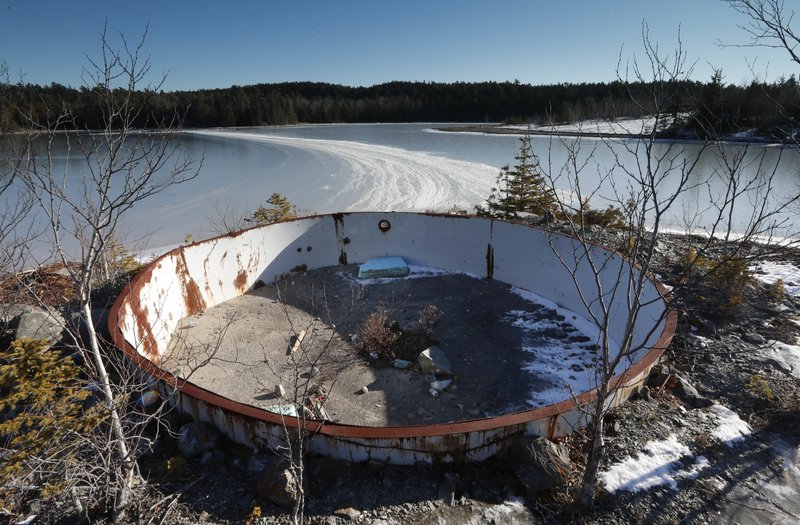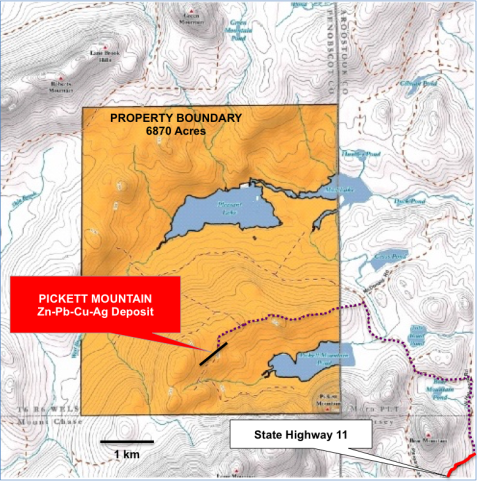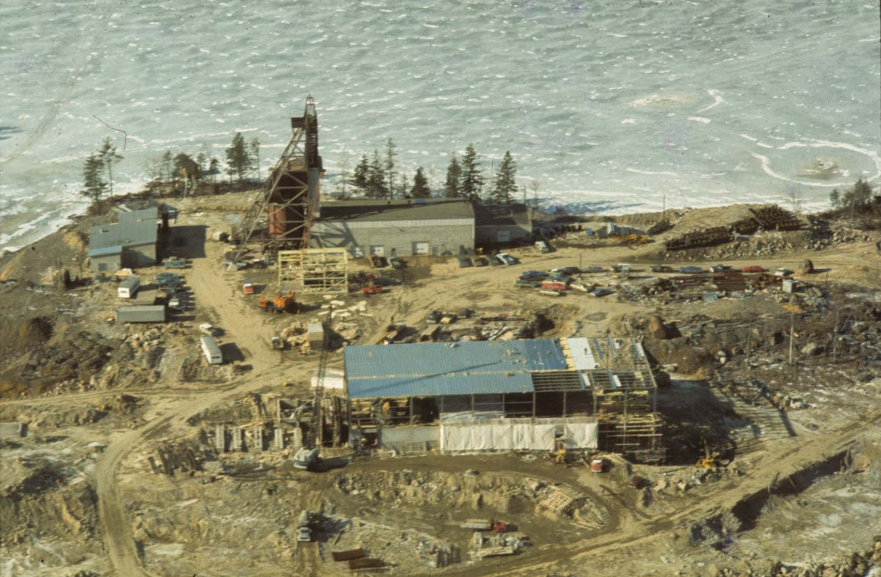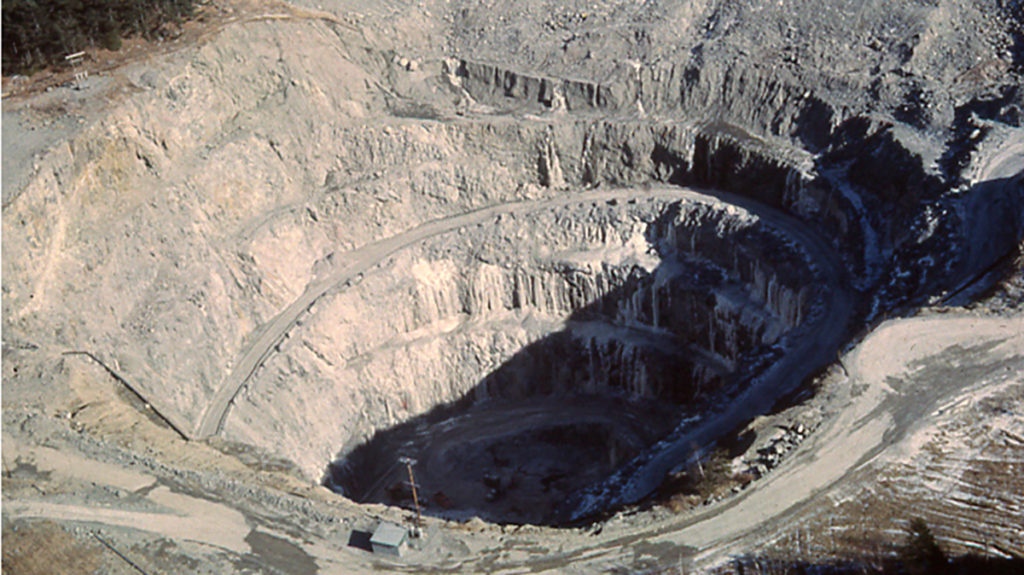A (Brief) History of Mining Law in Maine

Throughout Maine's history, common mineral resources of granite, limestone, peat, and gravel have been extracted. Metal mining, with its significantly more complex and caustic extraction, remains undeveloped. Only three operational metallic mines have been developed in Maine during the 20th century.
Metallic mining’s history in the state cannot be told without reference to two significant projects: Black Hawk Mine (Blue Hill) and Callahan Mine (Brooksville). History reveals that promises of positive regional economic impact, corporate accountability, and ecological safety were not achieved. Both mines have left behind toxic legacies of contamination, requiring expensive and ongoing maintenance.
Black Hawk Mine
In 1972 Kerramerican began mining near Blue Hill. Zinc and copper ore were extracted through an open pit mining operation to be sent out of state for processing. While initially promoted as a 10-20 year project that would employ 200-300 workers, the mine only operated for only five years and employed only 100. Reclamation that followed its 1977 termination was insufficient: the critical tailings cover eroded and studies revealed substantial contamination of ground and surface water. A mid 90’s investigation revealed that 10-20,000 lbs. of dissolved zinc was released into surface water annually from the waste rock storage system. To date the site requires continuous maintenance.
Callahan Mine
Brooksville, Maine was left devastated by contaminated soil, water, and sediment in the the aftermath of this open-pit zinc and copper mine disaster. Despite termination in 1972, the Callahan Mine Company project mine site was designated a Federal Superfund site in 2002. Today, after a cumulative clean up bill of $23 million dollars (10% shouldered by Maine), ongoing upkeep remains necessary. As a direct result, Mainers became reluctant to allow any further metallic mineral mining. Between 1972 and 2012 Mainers maintained a hardline stance against new legislation to allow for deregulation of this dangerous industry; metallic metal mining was effectively prohibited in Maine.
In 2002, the EPA identified these threats resulting from the Callahan Mine Project:
- High PCB soil contamination, unsafe for human contact
- Lead and arsenic bioaccumulation in regional biota
- Site groundwater deemed “unsuitable for human consumption”
- Excessive contamination levels from leakage and discharges posing significant hazards to aquatic organisms
In 2012, bill LD 1853 was introduced
by Representative John Martin of Eagle Lake at the behest of J.D. Irving, Limited, the Canada-based timber and energy conglomerate that owns Bald Mountain and roughly 1.25 million acres in Maine. John Martin and other sympathetic parties (including then governor Paul Le Page) pushed jobs as rationale to loosen Maine’s standards for water quality to allow for mining. They touted new mining technologies which supposedly rendered protections unnecessary after complaining, “[t]he rules written under the old law made it impossible to open a mine in Maine.”

Jeff Reardon, the New England conservation director for Trout Unlimited, an opponent of the Bald Mountain mine, stated, “I’m not worried about the water they treat, I’m worried about the groundwater and runoff water they can’t reach to treat.”
The concern from Reardon’s perspective considers the mountains of sulfide-bearing waste rock, tailings, and debris excavated from the mine will continue to leach highly acidic water for decades, possibly centuries after the mine has closed. Meanwhile contaminated water in the pit will seep into ground-water that flows from a mountain at the headwaters of Maine’s ecologically sensitive trout fishing region.
The changes made to Mining regulations in 2012 consisted of completely removing the Land Use Planning Commission (LUPC) from its previous role in the permitting process, shifting its oversight to zoning. Companies would now only need to acquire one permit through the state Department of Environmental Protection.
Other previously required permits were removed as well, including a Site Law permit, a Solid Waste Management Act permit, and a state stormwater permit. Required permits would now be processed by the DEP in a consolidated fashion.
Permit term limits were also removed from the process, a huge boon for the industry.
No longer would companies be required to renegotiate permits on an annual basis; instead, they would be allowed to retain their original permit for the lifetime of the mine. The re-permitting process was a critical safety measure, ensuring potential mining projects would be recurringly subjected to state scrutiny, allowing for identification and response to (inevitable) environmental and safety threats.
Nick Bennett, staff scientist for the Natural Resources Council of Maine (NRCM) expressed distress at the time:
“I was really shocked, actually panicked, because the bill did a number of really dangerous things, It greatly increased the amount of groundwater that could be polluted. It eliminated all the existing mining regulations immediately, while the new regulations wouldn’t go into effect for almost two years. It looked like a blank check for the mining industry.”
LD 1853 (2012) also proposed significant reduction of pre-existing capital assurance requirements designed to prevent a company from starting a project it did not have the financial backing to complete.
These requirements ensured that escrow monies were guaranteed for (inevitable) clean up work during the lifetime of the mine, and after the mines closure for “reclamation”.
Instead, under the new law, financial assurance requirements were met through surety bond, escrow, cash, trust, irrevocable letter of credit, or other equivalent security, subject to DEP approval. Notably, this legislation was an extreme change from the protective laws in place for decades and was intentionally rushed to accommodate J.D. Irving’s preferred timeline to begin extraction.
Lawmakers and the public were given less than 24 hours to process this proposal. No provisions for new protections and regulations within this new context were given. This proposal would have created a dangerous window in which legal protections were removed before any semblance of replacement were even described.
These requirements ensured that escrow monies were guaranteed for (inevitable) clean up work during the lifetime of the mine, and after the mines closure for “reclamation”.
Instead, under the new law, financial assurance requirements were met through surety bond, escrow, cash, trust, irrevocable letter of credit, or other equivalent security, subject to DEP approval. Notably, this legislation was an extreme change from the protective laws in place for decades and was intentionally rushed to accommodate J.D. Irving’s preferred timeline to begin extraction.
Lawmakers and the public were given less than 24 hours to process this proposal. No provisions for new protections and regulations within this new context were given. This proposal would have created a dangerous window in which legal protections were removed before any semblance of replacement were even described.
Luckily, provisions to prevent the legislation from immediately being implemented were put in place, disallowing new legislation before necessary specifics were worked out by the DEP.
Until further work could be done, the previous bill from 1991 would remain the law of the land as of 2014. J.D Irving’s plans for Bald Mountain were spoiled.
Twice since 2012 the Maine DEP’s attempts to create acceptable provisions under the 2012 law have been rejected by the Maine Legislature.
In 2017 a new mining bill, LD 820, presented by Sen. Everett Carson and co-sponsored by Sen. Mike Carpenter proposed to amend the 2012 law and define a range of new conditions for permitting metal mining.
On February 25, 2015, the Environment and Natural Resources Committee held a public hearing on mining rules (LD 146)...
The hearing demonstrated that Maine people from all parts of the state oppose weak mining rules. Twenty-four people from Aroostook County testified in person or submitted comments in opposition to the rules. Not a single citizen from Aroostook County testified or submitted comments in support of the rules. Individuals from 64 Maine communities spoke at the hearing or submitted comments in opposition, with the highest number of opposition comments from any one town coming from Presque Isle.
Only eight individuals total testified or submitted comments in support of the rules, and all were lobbyists representing Aroostook Timberlands and consulting firms seeking to benefit from mining in Maine.
“As far as I can tell from my research, both operations were fully licensed and permitted and conducted under the regulatory structure of the Maine Department of Environmental Protection. And yet, both left not only the scars of resource extraction upon the land, but have left environmental disasters with continuing heavy metal contamination of surface waters, groundwaters, and local biota.”
"My point is this: Forty years from now, how will the situation be any different? Why do we think that the rules we put in place today will be adequate for the needs of society forty years from now? Our rules from the 1970s, thought to be adequate then, have not served us so well. Therefore, the task of designing rules now that really will be adequate for the future will take more expertise and time than this committee has available in these few weeks. Let us learn from our past mistakes lest we repeat them."
Mining for Loopholes
(AKA Wolfden Resources Goes For It)
Wolfden has already shown its intent to circumvent Maine’s 2017 environmental regulation law) by buying land outright.
(LD820 forbids mine placement on state owned and designated lands.) Wolfden’s lawyers also attempted to prevent LUPC from examining factors of the petition, such as financial viability, waste disposal and environmental impact.
Even with the laws currently on the books it is not impossible for Wolfden to navigate its way to permittance which we already see (as evidenced above) they are willing to attempt. Wolfdens efforts to operate outside of environmental law will become even more of a possibility with support from local leadership.
We already know of a few examples where local leadership is cozy with Wolfden, or at least very friendly to mining like this in Maine, this is why we as citizens need to have our voices heard by LUPC directly and now!
If we allow LUPC to approve rezoning for a project that upon first glance clearly does not live up to the standards set by the laws of our land, we are undermining those laws and setting a precedent for other companies to see Maines’ environmental laws as mere suggestions to be ignored.
Wolfden’s lawyers also attempted to prevent LUPC from examining factors of the petition, such as financial viability, waste disposal and environmental impact.
Additional Reading
Metal Mining:
A Serious Threat to Maine
Read the Natural Resource Council of Maine's position on threats posed by mining
Mining in Maine: Characterization of Public Perceptions Investigator Report
2017 University of Maine Report for Maine Water Resources Research Institute
Metallic Mineral Mining in Maine
2013 Colby Honors Theses Paper by Kaitlyn Bernard (Colby College)

Although the proposed Pickett Mountain mine is the site currently in the crosshairs, if we don’t stop them now many other communities are at risk.
Wolfden Resources (Canada) purchased Pickett Mountain, large parcel of land in Patten, near Baxter State Park and Katahdin Woods and Waters National Monument. They recently petitioned the Maine Land Use Planning Commission (LUPC) to rezone 528 acres from a general management area to a planned development area for the future purpose of creating a large scale, deep mining project.
Currently LUPC is accepting comments from the public regarding Wolfden’s petition to rezone. Express your opposition by writing to [email protected] and visit LUPC for more details via the button below.


